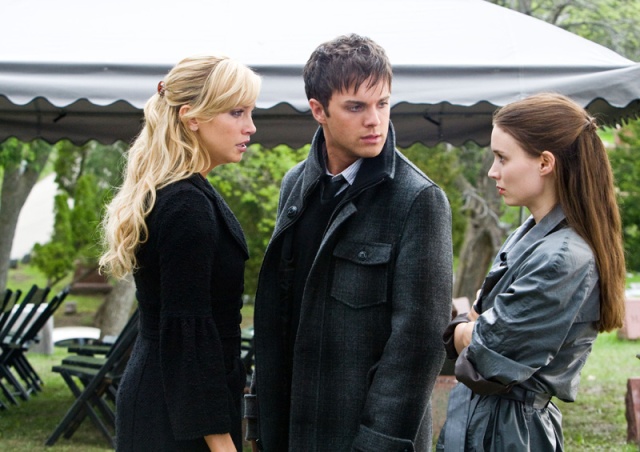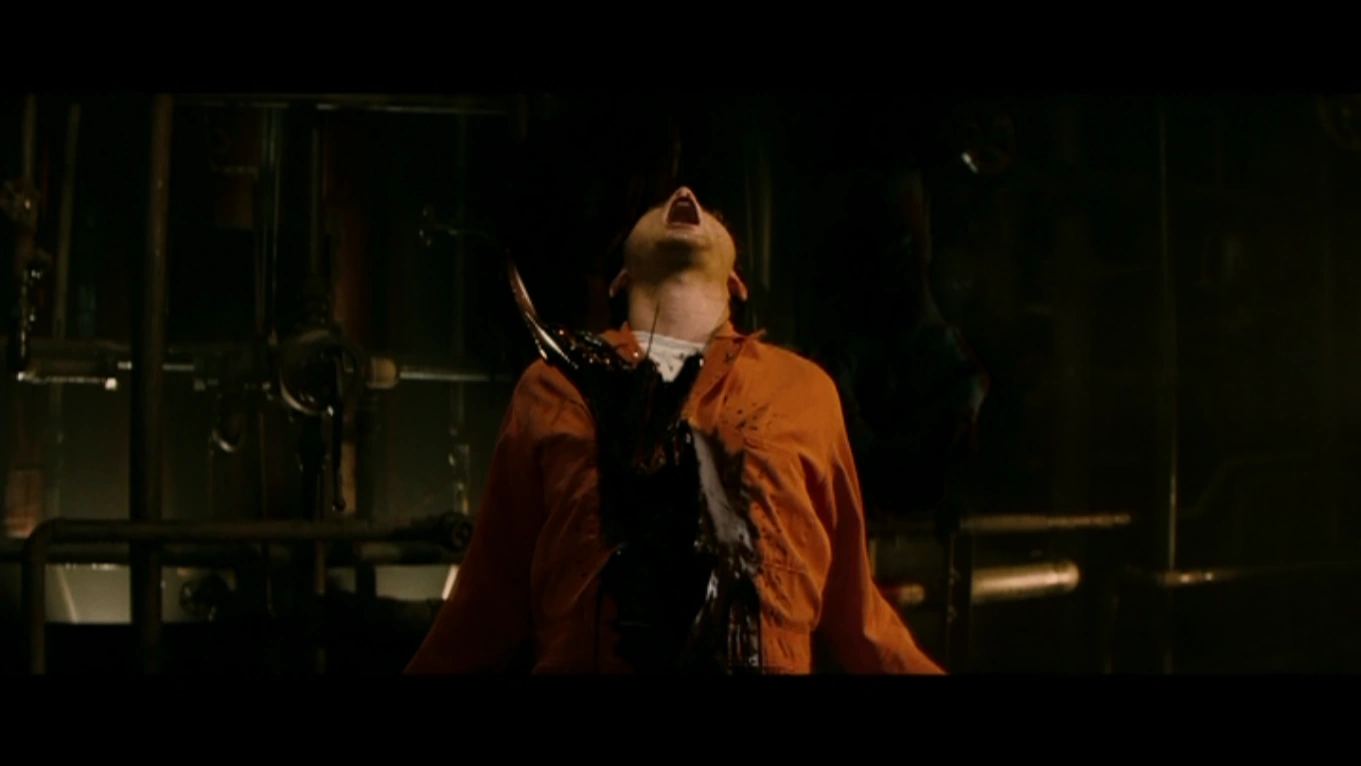"The only thing to fear, is fear himself" - Freddy.
I've now done two comparison articles on Friday the 13th and A Nightmare on Elm Street, so what better way to tie them together by reviewing the film that pitted the horror icons against one another? Freddy vs. Jason does exactly what you expect. It's an ultimately silly romp that's both entertaining and obviously flawed at the same time. Despite divided opinions on who should be victorious in the end, the film at least has some plus points and could be seen as the instigator for Hollywood to produce more crossover films, such as the following year's Alien vs. Predator.
The plot is bizarre, but it must have been difficult thinking up a plausible way to bring Freddy and Jason together in the same film. What we have here is Freddy using Jason to spread fear amongst the teens of Elm Street. Through that fear and remembering the terror Freddy caused, he will be able to return to stalk the teens once more. However, Jason refuses to cease his bloody rampage, killing many of the people Freddy wants for himself. This brings the two of them together in conflict, with the other characters caught in the middle, unsafe from Freddy in their dreams and equally at risk awake with Jason on the loose.
As you've probably guessed by now, any other characters besides Freddy and Jason become secondary to the enormous body count and fighting. The film introduces all new characters, and even try and give lead girl Lori (Monica Keena) a connection to Freddy. But before any semblance of depth can be created or any interesting interactions between the teens can take place, Jason shows up to hack his way through them all and then fight Freddy for the second half of the film. Part of the problem is the amount of characters introduced, as the film is already trying to balance having the two most iconic slasher villains together. So many characters quickly appear and then are killed off, which means they aren't memorable and only hinder the pacing of the film. The tone of the films is also a mess, with some appropriately dark material exploring Jason's mind and the opening showing a pre-demonic Freddy, which serves as a reminder as to just how twisted he is. However, the insanely over-the-top kills and strange dialogue (Freddy's appearance mockingly referred to as a "Christmas sweater" and his glove having "butter knives") destroys any seriousness. I don't mind the film having a sense of humour so that there isn't too much doom and gloom, but the attempts to be a bit less serious here are a major distraction, to the point where you can't even laugh at it in a "so bad it's good" kind of way.
Despite this, you get plenty of moments where Freddy and Jason share the screen. They don't just meet up at the end to battle, there are numerous instances of confrontation throughout. Robert Englund makes his final appearance to date as Freddy and is by far the standout performer. His usual enthusiasm for the role is a huge asset for the film, as he is the only character with dialogue to have any charisma. Then there's Jason, played by Ken Kirzinger, slightly redesigned after his "futuristic" look in 2002's Jason X. Kirzinger was a stunt double for Kane Hodder, who played Jason in Friday the 13th Part VIII: Jason Takes Manhattan. I really enjoy his performance as Jason, as he makes every move count. From the way he walks to how he fights, Kirzinger is a worthy successor to Hodder. Both he and Englund are fantastic in the film's gory showdowns, especially considering the obvious height difference between the two and the extensive makeup required for the characters. The fights are by far the best scenes in the film, featuring lots of blood and some pretty nifty choreography. For a film labelled as a horror, it is actually superior in the action department more than the scares. The ending leaves the winner open for debate, which I think is a smart move as the film clearly doesn't want to divide fans by having one of the characters clearly triumph over the other. If only the rest of the film could have the same level of positives as how the two villains are portrayed, I would care more than a little as to who wins (for the record, I prefer Freddy).
Freddy vs. Jason is an overall strange experience. The cool factor is raised to maximum when Freddy and Jason are together, but everything else is pretty stale. Without the two villains, the confused tone and disposable characters would not only plummet the film, but also prevent it from having anything unique whatsoever. But in the end, if you're really curious as to who wins or how a crossover between two popular slasher franchises could potentially work, then there are certainly worse examples out there than Freddy vs. Jason. Just don't expect the creativity of the original Nightmare on Elm Street or the atmosphere of the original Friday the 13th and you should get a kick out of it.
As you've probably guessed by now, any other characters besides Freddy and Jason become secondary to the enormous body count and fighting. The film introduces all new characters, and even try and give lead girl Lori (Monica Keena) a connection to Freddy. But before any semblance of depth can be created or any interesting interactions between the teens can take place, Jason shows up to hack his way through them all and then fight Freddy for the second half of the film. Part of the problem is the amount of characters introduced, as the film is already trying to balance having the two most iconic slasher villains together. So many characters quickly appear and then are killed off, which means they aren't memorable and only hinder the pacing of the film. The tone of the films is also a mess, with some appropriately dark material exploring Jason's mind and the opening showing a pre-demonic Freddy, which serves as a reminder as to just how twisted he is. However, the insanely over-the-top kills and strange dialogue (Freddy's appearance mockingly referred to as a "Christmas sweater" and his glove having "butter knives") destroys any seriousness. I don't mind the film having a sense of humour so that there isn't too much doom and gloom, but the attempts to be a bit less serious here are a major distraction, to the point where you can't even laugh at it in a "so bad it's good" kind of way.
Despite this, you get plenty of moments where Freddy and Jason share the screen. They don't just meet up at the end to battle, there are numerous instances of confrontation throughout. Robert Englund makes his final appearance to date as Freddy and is by far the standout performer. His usual enthusiasm for the role is a huge asset for the film, as he is the only character with dialogue to have any charisma. Then there's Jason, played by Ken Kirzinger, slightly redesigned after his "futuristic" look in 2002's Jason X. Kirzinger was a stunt double for Kane Hodder, who played Jason in Friday the 13th Part VIII: Jason Takes Manhattan. I really enjoy his performance as Jason, as he makes every move count. From the way he walks to how he fights, Kirzinger is a worthy successor to Hodder. Both he and Englund are fantastic in the film's gory showdowns, especially considering the obvious height difference between the two and the extensive makeup required for the characters. The fights are by far the best scenes in the film, featuring lots of blood and some pretty nifty choreography. For a film labelled as a horror, it is actually superior in the action department more than the scares. The ending leaves the winner open for debate, which I think is a smart move as the film clearly doesn't want to divide fans by having one of the characters clearly triumph over the other. If only the rest of the film could have the same level of positives as how the two villains are portrayed, I would care more than a little as to who wins (for the record, I prefer Freddy).
Freddy vs. Jason is an overall strange experience. The cool factor is raised to maximum when Freddy and Jason are together, but everything else is pretty stale. Without the two villains, the confused tone and disposable characters would not only plummet the film, but also prevent it from having anything unique whatsoever. But in the end, if you're really curious as to who wins or how a crossover between two popular slasher franchises could potentially work, then there are certainly worse examples out there than Freddy vs. Jason. Just don't expect the creativity of the original Nightmare on Elm Street or the atmosphere of the original Friday the 13th and you should get a kick out of it.























